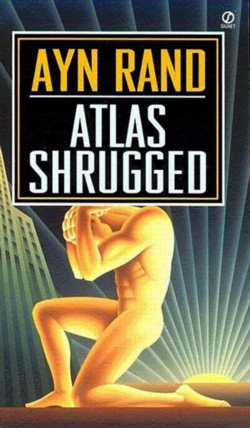…that Have Nothing to Do With Objectivism!
 Atlas Shrugged tells the story of Dagny Taggart, who, while technically only the vice president of Taggart Transcontinental Railway, is the true ruling power of the company. In the face of worldwide economic crises and nefarious politicians, she struggles to save her railway and revitalize the nation.
Atlas Shrugged tells the story of Dagny Taggart, who, while technically only the vice president of Taggart Transcontinental Railway, is the true ruling power of the company. In the face of worldwide economic crises and nefarious politicians, she struggles to save her railway and revitalize the nation.
This novel has been a source of ongoing controversy since its first publication in 1957. Ayn Rand considered this to be her magnum opus. Through the interwoven narratives of the industrial elite, she offers a full realization of her own ideological creation, objectivism. This unique philosophy is often the most divisive element of the novel.
But I’m not here to talk politics. Instead, I’m here to present some purely literary problems I found within the pages of “Atlas Shrugged.”
Before we begin, I feel I should say that this novel’s sheer length will not be counted against it. Yes, at over 1,000 pages, this tome is utterly massive. However, as someone who regularly struggles to meet even the most miniscule of word counts, I can’t help but admire her verbosity.
Anyway, let’s take a look at some of “Atlas’s” issues.
1. The Love Story
I congratulate Ayn Rand. By using heroine Dagny Taggart and her romantic entanglements, this author has created the first example I’ve ever seen of a love pentagon. Though, now that I think about it, one of the loves is never requited, so perhaps it’s more of a love square. . . with a little bit dangling off. … You know what? It’s a kite. It’s a love kite.
Now, I am no connoisseur of romance. The thought of leering into private sweet-nothing conversations is just off-putting. However, even I can tell that the romantic subplot of “Atlas Shrugged” is problematic, to say the least. Rand’s heroine flits from one suitor to the next, with little objection and even less consequence. This makes any sort of happiness the couples achieve feel unearned.
2. The Villains
The villains of Atlas Shrugged are Dickensian in the worst of ways. Multiple characters fill the role and they all appear to speak as one. Each is a simpering, fretful, and frighteningly one-note enemy.
That’s not to say that this character type can’t be done well. This book just doesn’t provide the right situation for it. These characters act with an exaggerated sneer before a background of harsh reality. It’s as if the pigs of “Animal Farm” controlled the world of “1984.” The two aspects work well apart, but they’re difficult to combine.
Rand puts these characters to use as mouthpieces for objectivism’s critics. While the inclusion of an opposing viewpoint is usually a laudable component in a work, to employ such unappealing characters as the sniveling James Taggart and the designing Lillian Rearden does more disservice to their views than simply excluding them altogether.
3. Hank Rearden
Hank Rearden, the questionably heroic owner of a steel mill and one of Dagny’s many, many love interests, is absolutely the worst character that I’ve had the literary misfortune to meet. My hatred began with the descriptions of his marriage. True, his wife Lillian is one of those whining antagonists, but even she deserves far better. Rearden is downright emotionally abusive. A crowded party scene provides a standout moment. After (correctly) suspecting her husband’s affair with Ms. Taggart, Lillian confronts the woman. However, she falters in her accusation, leading Rearden to demand she apologize in front of everyone.
Overall, my feelings toward the man can best be summed up in the joy I took in his being shot in a midnight raid near book’s end, and my subsequent disappointment in the fact that he does, indeed, live.
While many find philosophical meanderings to be the great flaw of “Atlas Shrugged,” I enjoy those sections most. After all, they provide a welcome respite from confused romance, pathetic villains, and conceited philanderers.
Written by Amelia Bailey for Intellectual Takeout ~ July 9, 2019
